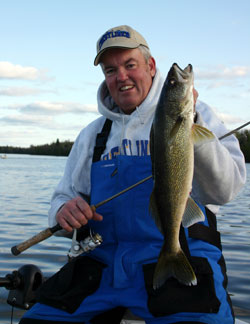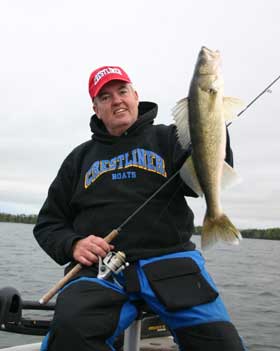
There’s a good reason jigs get called on so often early in the walleye season; fact is they always work! That doesn’t mean they’ll always work for you, but it’s a lead pipe cinch that somebody somewhere is putting a hurt on ol’ marble eyes and is doing it with the right jig in the right place, doing the right thing.
Jigging sounds simple enough but there’s more than one way to get the job done. They can be casted, trolled, or even fished straight up and down. What you do depends on where you are and the given conditions. If the fish are up shallow you probably won’t be fishing straight up and down and if they’re deep you likely won’t be trolling. Of course there are exceptions to all of the above.
Some years back I was pre-fishing for a tournament on Lake of the Woods in Northern Minnesota with Leech Lake guide and pro-fisherman Reggie Thiel. We found walleyes stacked along a shoreline flat that had two and three foot waves blowing in which really turned the fish on. Reggie’s an expert with a jig and suggested we put out the drift socks and slowly creep along with the wind and work a jig up and down in four to six feet of water. My inclination was to cast the bait a good distance from the boat because of the spooking factor but didn’t get bit as often or hook nearly as many fish as Reggie did who was working his bait almost straight up and down. Hooking big fish right below your feet on a short rope is a real gas and it didn’t take long for me to get with the program and we really spanked them.
I found another exception to the rule while pre-fishing for a big tournament on Leech Lake. Local wisdom suggested that it takes some wind and waves to trigger a good jig bite and was mostly true when it came to shallow water. When it went flat dead calm for three days of practice I finally moved out into twenty-two feet of water and started slowly trolling a jig along the bottom outside of the good shallow areas and found the walleyes, lots of them. It took a 1/4 oz jig and a slow troll to stay with the bottom but it really did work and helped me earn a decent paycheck.

Drifting or slowly trolling with a jig and minnow combination is an excellent early season tactic that allows you to cover some water. Most of the time spooking is a consideration and would be a good idea to get the bait away from the boat. The key is keeping it in the zone and having the feel to know what’s going on at the business end. Jigs that are just heavy enough to stay in contact with the bottom are part of the deal and could be as light as 1/32 oz or up to ½ when dealing with deeper water and heavy wind and waves. A good rod can make a huge difference and is why I use St. Croix’s TWS63MXF spinning combination. The 6’3” rod is more than good and has helped me pick up on light biting eyes and put a lot more fish in the boat. It also has the right action tip to allow a snap forward when trolling a jig and yet provide superior feel. Good trolling jigs have longer shank hooks which allow you to get the tip further back in a minnow and help nail the short strikers. Northland Tackles Shiner Jig has a long shank super sharp hook that was designed specifically for this purpose and is perfect for drifting or trolling and comes in some terrific colors. Speed is another critical component to successful drifting or trolling and why drift socks for windy days or trolling motors like Minn Kota’s incredible Vantage for calmer conditions are in order. The Vantage is a transom mount motor that has 3x steering and infinite speeds that will allow you to troll forward, backwards, or even sideways if you want, and stay in complete control.
Casting or pitching can also be effective early in the season, especially when the fish are up shallow and you’re dealing with clear or calm water. There’s almost always some fish shallow and maybe a lot more than you think. The key to hooking up with a few is keeping your presence to yourself and that means staying off the top of the fish and pitching or casting to key areas. Last year on a northern Minnesota lake we found huge numbers of early season fish in six to eight and feet of water and some as shallow as a few feet. Those shallower fish were aggressive and an easy number for a 1/16 oz Fireball tipped with a shiner pitched up to the shoreline and slowly worked back along the bottom. They’d scarf them up and start heading for deeper water and you’d have to wait a few seconds before setting the hook or you’d come up empty every time. That was until the first boat made a pass up in that same shallow water and pushed them off. It shut the pattern down and didn’t really fire up again until the next morning, that was until the first boat made a shallow drift again…
Keep smiling and see you on the water.










